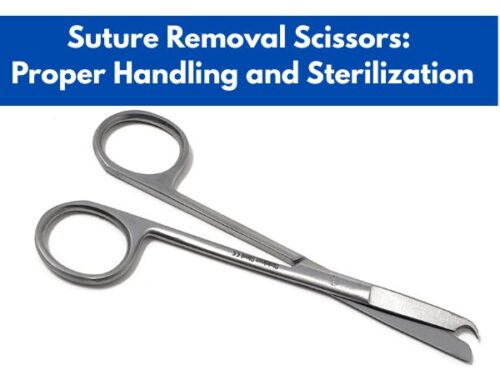Insulin Syringes vs Insulin Pumps: Which Is Right for You?

According to the American Diabetic Association (ADA), nearly 8.4 million Americans require a daily dose of insulin. However, every 1 in 4 of these diabetic patients either skip their dose or inject fewer units than needed thus leading to serious consequences. One of the reasons behind this problem is the lack of affordable insulin delivery systems. Nowadays, devices like insulin syringes vs insulin pumps have been introduced which are not only accurate but also budget-friendly.

In this article, let us go through what insulin syringes vs insulin pumps are, how they work, and which one is better for you depending on your needs. In addition, some notable brands of insulin syringes vs insulin pumps have also been discussed.
Insulin Pumps: Wearable Insulin Delivery System
Insulin pumps are the medical devices that are attached to the skin surface. Once in place, these insulin pumps maintain a continuous supply of insulin to the tissue which is then absorbed into the body. Usually, rapid-acting insulin is injected using insulin pumps.
These pumps are often recommended owing to their features such as their compact size as these are extremely small and lightweight and can be easily carried around.
Insulin pumps are rapidly being integrated with continuous glucose monitors (CGM) which can adjust the supply of insulin automatically based on the patient’s needs.
How Do They Work?
An insulin pump delivers insulin to the body at varying rates. These can provide small continuous insulin doses as well as inject the higher concentrations of insulin which are often needed after a meal. The patients just have to enter the amount of carbohydrates they are having during a meal.
The insulin pump then calculates the insulin dose the patient will need to metabolize that much carbohydrates. Once the calculations are done, the insulin pump injects the medication immediately. As an insulin pump works just like the pancreas, the body part responsible for releasing insulin into the body, it is said to mimic the body’s normal basal insulin-releasing mechanism.
Types
Insulin pumps can be divided into two categories:
· Tubed Insulin Pumps
In the case of a tubed insulin pump, the insulin pump uses a long tube to connect with the flexible plastic cannula which is attached to the skin of the belly, upper arm, hips, or thighs. Once the pump releases insulin from its reservoir, the tube has the job of delivering it to the cannula from where the insulin gets into the body.
· Tubeless Insulin Pumps or Patch Pumps
In tubeless insulin pumps, the insulin reservoir as well as the cannula are combined to form a patch that is attached to the skin, hence the name patch pumps. The reservoir can directly deliver insulin to the cannula so the need for a tubing is eliminated. These tubeless insulin pumps are more convenient for the patients as these can be easily worn under the clothes without being much visible.
Both the tubed and tubeless insulin pumps require reservoir replacement every 2 to 3 days.

Merits
The insulin pumps have the following merits:
- The insulin pumps provide flexibility in dosing to diabetic patients. This way, the patient does not have to alter their lifestyle due to the medication timings.
- With the employment of insulin pumps, dosage precision is ensured.
- The insulin pumps also lower the risk of hypoglycemia (lower than normal blood glucose levels) or hyperglycemia (higher than normal blood glucose levels).
- With the use of insulin pumps, the need to inject insulin with a syringe is eliminated.
- patients who have unpredictable eating schedules throughout the day particularly benefit from insulin pumps.
- Due to their high safety, the Food and Drug Administration (FDA) has approved the use of insulin pumps for individuals as young as 2 years old for the purpose of managing their blood glucose levels.
Demerits
Despite their several advantages, insulin pumps are not for everyone. These come with the following demerits and limitations:
- As the use of an insulin pump requires auto-adjusting the calorie intake as well as changing the reservoir, the patient needs to be in a state to enter data with their fingers. If that is not the case, the help of a caregiver is required.
- If the patient has visual impairment, the use of insulin pumps might not be a good idea.
- Some people might experience an allergic reaction due to wearing an insulin pump.
Insulin Syringes: Conventional Insulin Delivery Devices
Insulin syringes are the conventionally employed method for insulin delivery. These are made up of polypropylene which is resistant to pressure and have stainless steel needles. Different sizes of insulin needles require different gauge sizes and lengths of the needles with them.
How Do They Work?
Using a vial and syringe is simple to provide insulin therapy. A sterilized needle is attached to the syringe and fitted in its place. The insulin from the vial is filled into the barrel of the syringe followed by subcutaneous i.e. the skin insertion. As soon as this insulin enters the bloodstream, it starts shifting glucose from the blood into the cells to achieve low blood sugar levels.
Merits
The insulin needles provide the following advantages:
- These are easy to employ devices.
- With the use of an insulin syringe, it is uncomplicated to learn how to measure the required insulin units (IU).
- The insulin syringes are lightweight and easy to carry.
- Due to the presence of silicone coating on the needles, the overall patient experience with insulin syringes becomes pain-free.
- The best feature of the insulin syringes is their extremely low cost as compared to other insulin delivery options.
Demerits
Being a conventional system, insulin syringes have several demerits. Some of these are as follows:
- There is a higher risk of dosage inaccuracy with the use of insulin syringes.
- The process of delivering insulin with an insulin syringe is time-consuming and needs expertise.
- If the needle is not inserted properly, it can cause damage to the deeper tissues.
- With the use of insulin syringes, the patients often experience pain and discomfort.
- For the caregiver, the chances of getting needlestick injuries are also higher while handling insulin syringes.
Insulin Syringes vs Insulin Pumps: What is the Difference?
Both insulin syringes vs insulin pumps are in use by the patients who are dealing with diabetes. However, when choosing an insulin delivery system for your patient, it is good to go through the features of insulin syringes vs insulin pumps to make a final decision. The following table enlists a comparison of the features of insulin syringes vs insulin pumps:
| Features | Insulin Syringes | Insulin Pumps |
| Automatic insulin injection | ✘ | ✔ |
| Flexibility of dosing | ✘ | ✔ |
| Accuracy and precision | Less precise | High precision |
| Painful drug delivery | ✔ | ✘ |
| Risk of glycemic episodes | High | Low to none |
| Risk of infection | ✔ | ✔ |
| Risk of diabetic ketoacidosis | ✘ | ✔ |
| Suitability for visually impaired patients | ✘ | ✘ |
| Portability | Low | High |
| Cost-effectiveness | ✔ | ✘ |
| Insurance coverage | Usually absent | Usually absent |
Insulin Syringes vs Insulin Pumps: Which One is Right for You?
An insulin pump should be given preference over insulin syringes if:
- The patient experiences high swings in blood glucose levels
- The hypoglycemic or hyperglycemic episodes are a common occurrence
- The patient often experiences delays in their food absorption
- The patient needs a flexible and active lifestyle
- The patient is from the pediatric group and does not want to take injections multiple times a day
- The women who are planning to get pregnant

Insulin Syringes vs Insulin Pumps at Health Supply 770: Products and Features
Insulin syringes vs insulin pumps are the insulin delivery systems that are known for their efficiency and reliable performance. Both of these systems deliver the medication subcutaneously i.e. under the skin and can be used easily.
Owing to their rising demand, multiple brands of insulin syringes vs insulin pumps have been launched. In this regard, many different kinds of insulin syringes vs insulin pumps are available at the Health Supply 770 and have been detailed below along with their prices and purchase links:
True Comfort Pro Insulin Syringes 30G ½ cc and 1 cc
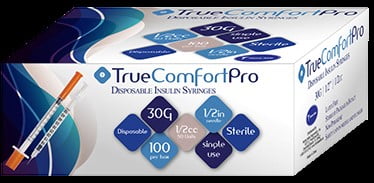
$159.88
True Comfort Pro Insulin Syringes 30G 1/2cc 1/2″
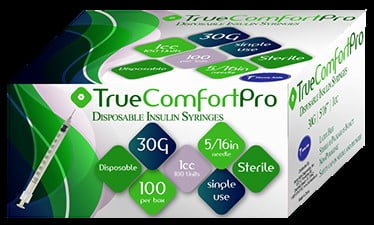
$159.88
True Comfort Pro Insulin Syringes 30G 1cc 5/16″
Product Details
True Comfort Pro insulin syringes are excellent in their build and functionality and are a great choice for administering insulin. These are a product of Home Aide Diagnostics, Inc. Their gauge size is 30 G and they come with volume capacities of ½ cc and 1 cc respectively. With different barrel sizes, these insulin syringes can be employed by different patients for delivering different insulin doses.
The stainless steel needles that come with the True Comfort insulin syringes are ½ inch in length. A 100 insulin syringes come in a single box which makes them affordable and inexpensive. Being an over-the-counter product, these True Comfort pro insulin syringes are available online as well as at pharmacies all over the US.
Easy Comfort Pro Insulin Syringes 30G ½ cc ½” and 31G ½ cc 5/16”

$156.00
Easy Comfort Insulin Syringe 30G 1/2cc 1/2″
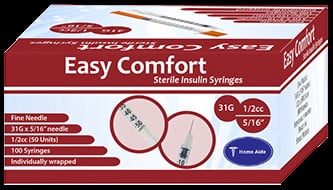
$162.88
Easy Comfort Insulin Syringe 31G 1/2CC 5/16″
Product Details
Among various insulin syringes vs insulin pumps, these Easy Comfort pro insulin syringes are one of the finest insulin syringes employed to administer insulin. The gauge sizes of these needles are 30 G and 31 G respectively. In addition, both of these products have the same volume capacity i.e. ½ cc.
With their finer build, these syringes have needles that do not cause pain and discomfort during and after injection. The lengths of these Easy Comfort pro insulin syringe needles are ½ inches and 5/16 inches. Moreover, each piece of the product is individually packed to ensure no contamination.
Cardinal 8881893010 Safety Insulin Syringe with Needle Magellan™ 1 ML 5/16 Inch 30 Gauge Sliding Safety Needle Regular Wall 500/CS
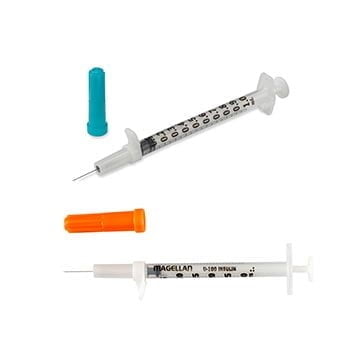
$299.88
Product Details
Cardinal safety insulin single-use syringes are a product of Magellan and are often preferred by healthcare providers as well. Their volume capacity is up to 1 ml and their gauge size is 30 G. Their needles are constructed using high-quality stainless steel and have a length of 5/16 inches.
In addition, the needles are pre-sterilized and come in individual packaging. Their construction material is medical-grade polypropylene which is strong and reliable. Moreover, the graduations on these syringes are clear and thus allow easy visualization.
Medi-Belt Insulin Pump Belts

Small: $27.88
Medi-Belt Insulin Pump Belt, 22″ – 26″, Small, Black
Large: $27.88
Medi-Belt Insulin Pump Belt, 33″ – 45″, Large, Black
Product Details
Medi-Belt insulin pump belts come in two different sizes i.e. the smaller one is 22” to 26” while the larger one is 33” to 45”. These belts are best to carry insulin pumps on the skin as they are comfortable to wear. Moreover, these snug perfectly on the waist and are flat so they do not become bulgy below the clothes.
Their construction material is Lycra which is smooth, soft, and of high quality. There are no zippers, clips, ties, or Velcro on these belts. In addition, the storage pockets allow the patient to store essential diabetic supplies.
*Note: The prices of the insulin syringes vs insulin pumps mentioned in the article are taken from the Health Supply 770 website. These may vary depending on the vendor.

All types of insulin syringes vs insulin pumps mentioned in the article, along with many other medical supplies, can be ordered from Health Supply 770, a reliable name when it comes to medical products. They have a 30-day money-back guarantee and provide your products to you in the shortest possible time. Click the links given in the article to check out the wide range of insulin syringes vs insulin pumps as well as many other kinds of diabetes technology.
Bottom Line
Diabetic patients often face confusion while choosing a suitable insulin delivery system for them. With so many options in the market, it is difficult to go through every product and select the best. Among these products, insulin syringes vs insulin pumps are notable.
Both the insulin syringes vs insulin pumps deliver insulin safely. However, the insulin syringes need to be used multiple times a day which is often inconvenient as well as painful for the patient. In comparison, an insulin pump provides nearly painless insulin delivery with minimum discomfort.
Overall, both the systems have their own merits and demerits and the choice needs to be made based on the patient’s needs as well as the physician’s requirements. For purchasing different kinds of insulin syringes vs insulin pumps, reliable vendors like Health Supply 770 should be approached. They ensure the provision of quality products along with satisfactory services.
References















